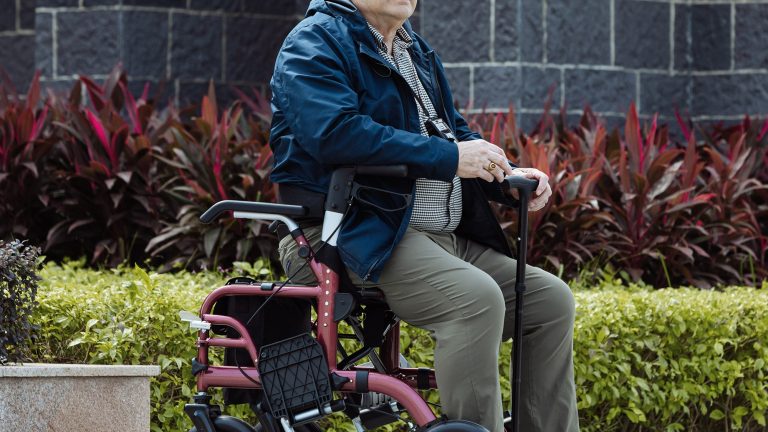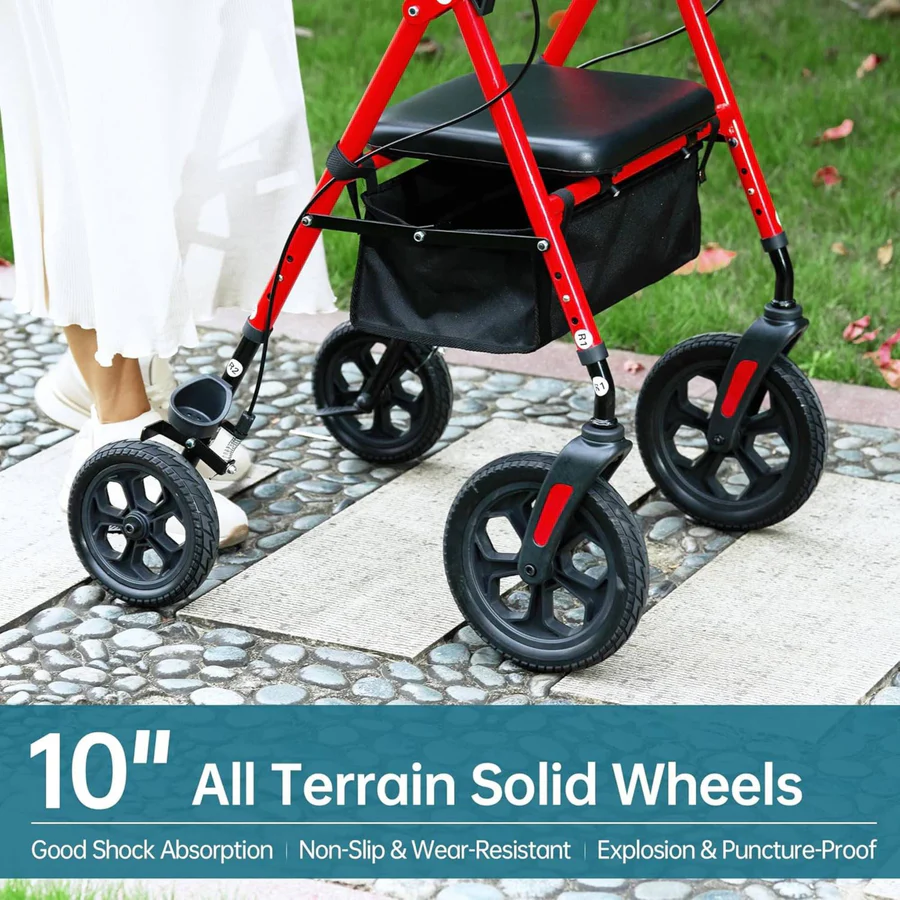If you’re someone who loves the outdoors but needs a little help getting around, you’ve probably wondered about the magic of an all-terrain walker. These specialized walkers promise to help you stay mobile and independent on rough surfaces like dirt paths, gravel, grass, and even uneven trails. But the big question is: Do all-terrain walkers really work on all terrains? Let’s dig into that and see if these walkers live up to the hype.
What Is an All-Terrain Walker?
An all-terrain walker is a mobility aid designed for use on a variety of surfaces, not just the smooth floors of your house. These walkers come with sturdy wheels (often larger and more durable than standard walker wheels) to help you glide over rougher surfaces. They’re meant to offer more freedom, allowing users to navigate gravel paths, grassy areas, or even dirt trails with ease.
While traditional rolling walkers or rollator walkers are great for smooth surfaces like indoor floors or sidewalks, all-terrain walkers are built to handle more rugged ground. They’re typically equipped with features like large, durable wheels, often 8 inches or more in diameter, which help distribute weight and absorb shock. Some even come with seats, giving you the option to take a break while you’re out exploring.
For example, an Elenker walker is a popular model that’s known for its durability and comfort, designed to handle outdoor surfaces while offering support and stability. The rollator walker with seat feature is another great option, as it allows users to rest while on longer walks in parks or during outdoor activities.
How Do All-Terrain Walkers Perform on Different Surfaces?
Now that we know what an all-terrain walker is, let’s take a closer look at how well it works on various surfaces.
Grass and Lawns
One of the biggest advantages of an all-terrain walker is its ability to handle grassy areas, which can be difficult for standard walkers. If you’ve ever tried pushing a regular rolling walker or rollator walker over grass, you know how frustrating it can be. The wheels tend to get stuck or bog down, making it hard to move forward. All-terrain walkers, however, are designed to roll smoothly over grass. The larger, wider wheels provide better traction and help the walker glide over uneven ground. So, whether you’re walking through a park or taking a stroll in your yard, an all-terrain walker will give you much more ease and stability than a regular walker with no wheels.
Gravel and Dirt Paths
When you move beyond grass and onto gravel or dirt trails, you might start to wonder if an all-terrain walker can really handle the rougher surface. The answer is, yes, in most cases, it can. The key is the design of the wheels. All-terrain walkers are built with sturdier, more robust wheels that are capable of navigating loose or uneven ground. These walkers typically have larger, air-filled tires (similar to those on bicycles), which help absorb the bumps and jolts of walking on gravel or dirt paths. Whether you’re out for a walk in the woods or trying to navigate a gravel driveway, an all-terrain walker can make the experience much smoother and less tiring. It’s much more practical than trying to push a standard rollator walker with smaller wheels over such terrain.
Uneven Trails and Hills
If you love hiking or walking on trails with varying elevations, you might wonder if an all-terrain walker can handle inclines and uneven ground. The short answer is, yes, but with a few caveats. All-terrain walkers can usually manage moderately uneven trails, such as those found in parks or nature reserves, thanks to their larger wheels and shock-absorbing features. However, it’s important to note that these walkers are not the same as full-on hiking equipment like walking sticks or trekking poles. While an all-terrain walker can handle mild inclines and uneven trails, steep hills or highly rugged terrains may still be a challenge, especially if you’re not used to walking on them. It’s always a good idea to test the walker on the terrain you plan to navigate most often to ensure it meets your needs.
Sand
Here’s where things get a little tricky. While an all-terrain walker can handle many rough terrains, sand is a particularly difficult surface for any type of walker. Whether you’re walking on a beach or trying to navigate through a sandy park path, all-terrain walkers may struggle. The wheels, even if they are large and durable, will likely sink into soft sand and make movement difficult. If you plan to walk on sandy surfaces often, a more specialized piece of equipment, like a beach wheelchair, may be a better option. However, if you’re just looking to occasionally cross a beach or sandy area, an all-terrain walker might still be helpful, but it will likely require more effort to move through the sand.
Are All-Terrain Walkers Comfortable to Use?
Comfort is another important consideration when choosing an all-terrain walker. After all, you’ll want to make sure that the walker doesn’t just perform well on rough surfaces but also offers comfort for long walks or trips.
Seats for Resting
Many rollator walkers with seats are designed to give users a chance to rest while out and about. These walkers often include padded seats that allow you to take a break whenever you need. This is especially helpful when walking for extended periods of time, whether you’re exploring a park or taking a walk through your neighborhood. The Elenker walker, for example, offers a comfortable seat and is great for outdoor use. Its seat feature allows you to pause and rest when needed, which can be a lifesaver for those with limited endurance or stamina.
Shock Absorption and Smooth Ride
One of the most significant features of an all-terrain walker is its ability to provide a smooth and comfortable ride, even on rough surfaces. The larger wheels, along with the shock-absorbing suspension, ensure that the walker absorbs much of the impact when you’re walking over bumpy, uneven ground. This reduces the strain on your body and makes walking on rougher terrains feel less jarring.
Adjustability and Custom Fit
Like most rollator walkers, all-terrain walkers are often adjustable to fit your specific height and needs. Adjustable handles, brakes, and even the seat height allow you to customize the walker to your body, making it more comfortable and supportive. Ensuring that the walker fits you properly will help reduce any discomfort during use.
Are All-Terrain Walkers Worth It?
If you’re someone who loves spending time outdoors and needs a mobility aid that can keep up with you, an all-terrain walker could be a great investment. They offer increased mobility, support, and comfort, especially when walking on grass, gravel, dirt paths, and uneven trails.
However, as we’ve seen, they do have some limitations. Soft sand, steep hills, and extremely rough terrains might still pose challenges, but for most everyday outdoor adventures, an all-terrain walker is more than up to the task. Additionally, if you already have a rollator walker with seat, upgrading to an all-terrain model could make a huge difference in your ability to move around freely and confidently.
All-terrain walkers do work on many types of terrains, offering stability and comfort that a traditional rolling walker can’t always provide. They’re great for outdoor enthusiasts who enjoy walking on grass, gravel, dirt paths, and other uneven surfaces. But like any mobility aid, they’re not perfect for every surface, so it’s essential to consider where you’ll be using the walker most.
For those who need extra help navigating rough terrains, the Elenker walker and other rollator walkers with seats can provide the support you need to stay active and independent. Whether you’re walking through a park or just want to get out and explore, an all-terrain walker can make a world of difference in how you experience the outdoors.



